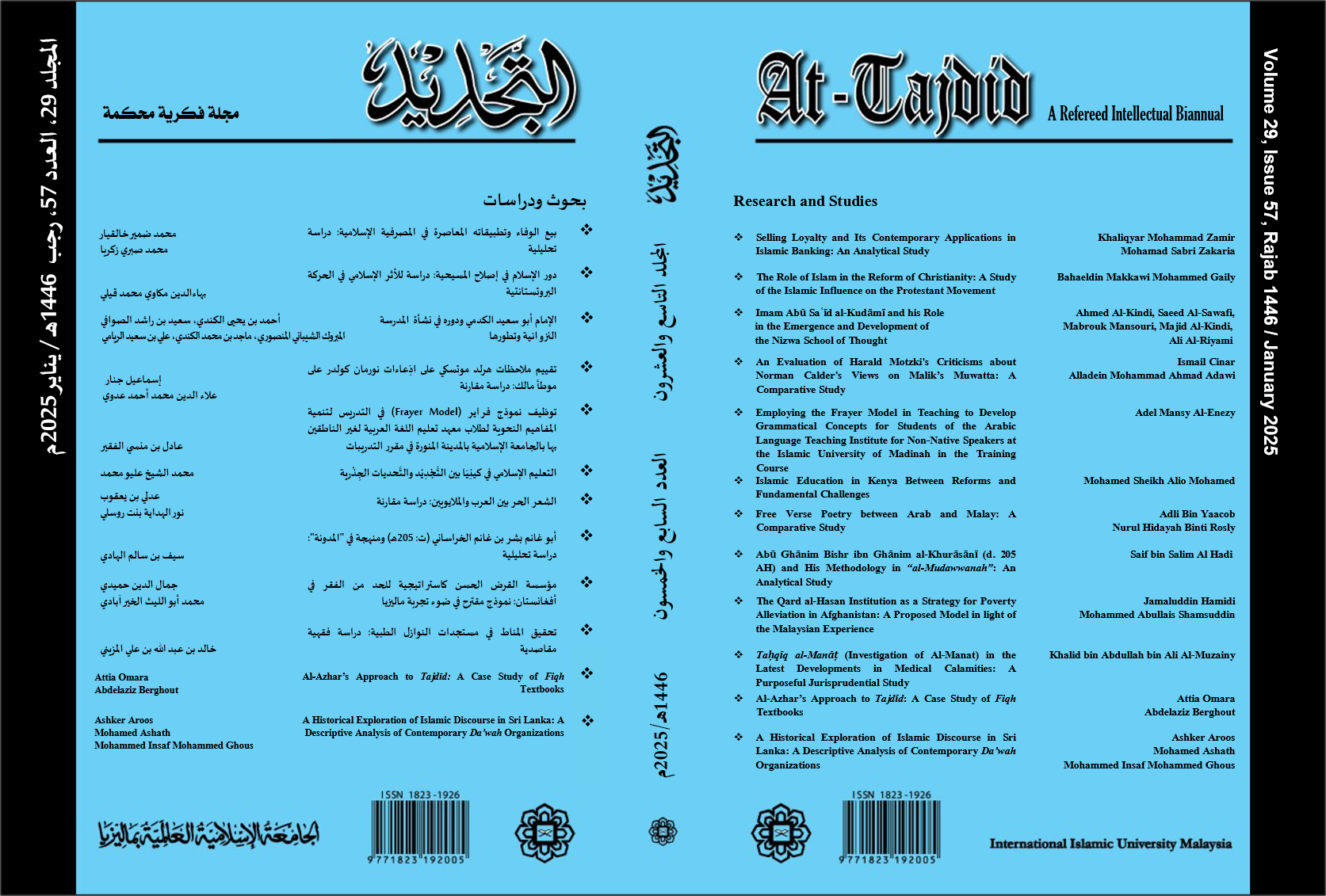التعليم الإسلامي في كينِيَا بين التَّجْدِيْد والتَّحديات الجِذْرية
(Islamic Education in Kenya Between Reforms and Fundamental Challenges)
Abstract
Islam extended to the shores of East Africa during the Umayyad Caliphate through Muslim immigrants who came to the region for economic or political reasons. Later, successive waves of immigration and interactions between the arriving Muslims and the native citizens followed, allowing Islam to take hold throughout the region. New Islamic emirates and settlements distinguished by knowledge, scholarship and the manifestations of Islamic civilization were established along the East African coastal line. Among the social institutions that emerged with the advent of Islam in East Africa were the Islamic schools, which went through various forms and phases and played the most important role in transmitting Islamic knowledge and civilization across generations as well as in strengthening Islamic culture and identity. The aim of this research is to shed light on the history of Islamic education in Kenya by examining the historical background, phases, categories, developments and reforms implemented. Furthermore, the study evaluates the impending fundamental challenges that prevent Islamic education in Kenya from fulfilling its mission and provides some suggestions to address these challenges to move forward. The research adopts both the inductive analytical and historical approaches. The data is collected as primary sources from library and electronic materials, university theses, peer-reviewed journals and conference proceedings. The information was classified, analyzed and documented later to achieve a harmonious and well-documented study that connects past, present and future. The article concludes that Islamic education in Kenya has gone through various stages and forms since the arrival of Islam to the coasts of East Africa during the first century of Hijrah. It displays that the Islamic education was exposed to administrative and methodological obstacles during British colony (1895-1963), but it did not stop or disappear. Rather, reforms occurred in terms of introducing ‘Islamic education’ and ‘Arabic language’ to the state education curriculum, the emergence of integrated schools and Islamic universities at higher education level. However, the Kenyan Islamic education still faces huge fundamental setbacks that embodied in lack of official legal reference, in addition to administrative, curriculum, personnel and financial challenges. The paper recommends conducting more studies on Islamic education in Kenya in a manner that contributes to the comprehensive reconstruction and advancement of Muslim education in Kenya and East Africa at large.
Keywords: Islamic Education, Kenya, Islamic Education Renewal, Islamic Education Reform, Fundamental Challenges.
Downloads
References
Abdi, Aden Ali. “Integration of Islamic and Secular Education in Kenya: A Synthesis of the Literature,” International Journal of Social Science and Humanities Research 5, no. 3 (2017), 67-75.
Abreau, E. “The role of Voluntary organizations in Education with Special Reference to African and Asian Communities,” Kenya Historical Review Journal 4, no. 2 (1976), 207-232.
Aḥmad, Aḥmad ،Abduh. “Al-Tʿalīm al-Islāmī fī kīniyā – Al-ḥulūlu wa al-Taḥadiyyat”, Baḥthun ḍimn awrāqi Mu’tamar al-Tʿalīm al-Islāmī fī kīniyā (Nairobi: Ṭabʿat Jāmiʿat al-Ummah,1441H-2019).
Al Mazrūʿī, Shaykh Al-Amīn Bin ʿAli. The History of The Mazruʿi Dynasty of Mombasa, Translated and annotated by J. McL. Ritchie (London: The British Academy, Oxford University Press, 1995).
Al-Duwaysh, Muḥammad bin ʿAbdallah. “Al-Tʿalīm al-Islāmī al-ʿArabī fī ifrīqīyā”, Majallat (Qirā’āt ifrīqiyyah), al-ʿadad al-‘awaal, Ramaḍān 1425H/aktobar, 2004).
Ali, Ali Adan, “Historical Development of Muslim Education in East Africa: An Eye on Kenya”, Journal of Education in Muslim Societies 4, no. 1 (2022), 128-139.
Al-Ṭaī, ʿAbdallah Ibn Muḥammad. Tārīkhu ‘Ummān al-Siyāsī (Kuwait: Maktabat al-Rubaiʿān lil-nashri wa-al-tawzīʿ, 2008).
Al-ʿubūdī, Muḥamad bin Nāṣir, Fī ifrīqiyā al-Khaḍrā’, Mashāhid wa inṭibāʿātun wa aḥādīthun ʿan al-islāmi wa al-Muslimīna (Beirūt: Dār al-Thaqāfah, 1968).
Ashkir, Muḥamad Ḥassan. “Taḥdiyyāt al-Tʿalīm al-Islāmī dūn al-jāmʿī fī kīnīā”, Baḥthun ḍimn awrāqi Mu’tamar al-Tʿalīm al-Islāmī fī kīniyā (Nairobi: Ṭabʿat Jāmiʿat al-Ummah,1441H-2019).
Hansard (Commons), 13 June 1895, col. 1086-88.
Ḥarrān, Tāj al-Sirr Aḥmad. Al-‘Aqaliyyah al-Islāmiyyah fī Kīniyā (Al-Riyāḍ: Jāmaʿat al-Malik Saʿūd, Wuḥdat Buḥūth al-Tārīkh biʿimādat al-Baḥth al-ʿIlmī, 1421H/ 2000).
Jābī, Kulibālī Hārūn. “Taqwim Manāhiji al-Tarbiyah al-Islāmiyyah li al-Marḥalah al-Mutawasiṭah bi al-Madāris al-Ahliyyah fī Mālī” (Risālat Mājistīr, Jāmiʿat Ummudurmān al-Islāmiyyah 1997m).
Juma M., Shaban. “The challenges of teaching Islamic religious education on spiritual and academic formation of secondary school students in Nairobi, Kenya”, (MA Thesis, Kenyatta University, 2012).
Kassim, Salim. “The Role of Islamic Religious Education and Arabic Language in Kenya.”, Proceedings of the first Islamic education conference in Kenya (Nairobi: Umma University, 2019), 36.
Maina, Newton Kahumbi, “Muslim Education in Kenya with Special Reference to Madrasa System in Nairobi,” (MA Thesis, Kenyatta University, 1992).
Maina, Newton Kahumbi. “Christian-Muslim Relations in Kenya,” In Islam in Kenya, ed. Mohamed Bakari and Saad Said Yahya (Nairobi: Mewa Publications, 1995), 116-141.
Maina, Newton Kahumbi. “The historical roots of conflicts between Christians and Muslims in Kenya,” In Interfaith Dialogue: Towards a culture of Working Together, ed. Frederic Ntedika Mvumbi (Nairobi: The Catholic University of Eastern Africa, 2009), 77-99.
Maʿshī, Jamīlah ʿAbdū. “Juhūd al-Mazāriʿah fī Nashri al-Islāmi fī Sharq Afrīqiyā: Dirāsah Tārīkhiyyah Ḥaḍāriyyah” (Kulliyat al-Sharī،ah wa al-Qānūn, Jāmi،at Umm Al-Qurā, 2014).
Muḥammad, ʿAbdallāh Muaḥmmad. “Tajrubat al-Madāris al-Damjiyyah wa Dauruhā fī al-Tʿalīm al-Islāmī”, Baḥthun ḍimn awrāqi Mu’tamar al-Tʿalīm al-Islāmī fī kīniyā (Nairobi: Ṭabʿat Jāmiʿat al-Ummah,1441H-2019).
Mūsā, Yūnus ʿAbdlulle. “Daūr al-Madāris al-Islāmiyyah fī al-Tʿalīm al-Islāmī fī kīniyā”, Baḥthun ḍimn awrāqi Mu’tamar al-Tʿalīm al-Islāmī fī kīniyā (Nairobi: Ṭabʿat Jāmiʿat al-Ummah,1441H-2019).
Salim, Swalha. “A History of the Yemeni Arabs in Kenya,” (MA thesis, University of Nairobi, 1983).
https://en.wikipedia.org/wiki/Education_in_Kenya
https://victormatara.com/list-of-best-islamic-secondary-schools-in-kenya/#google_vignette
https://www.facebook.com/people/Almustaqbaluniversity/100069722544943/
https://www.iua.edu.sd/collages/raf-islamic




















